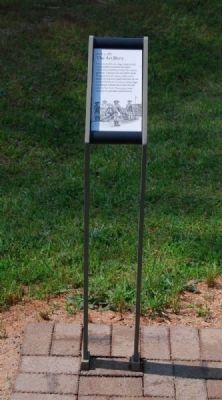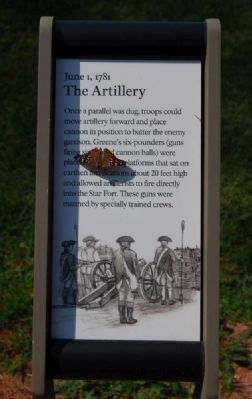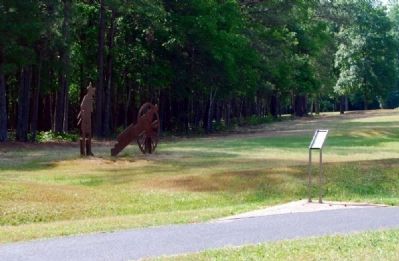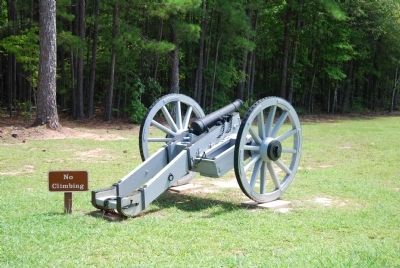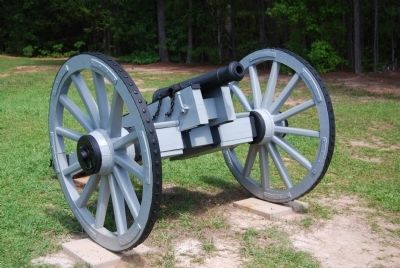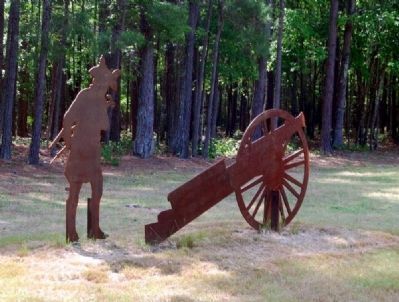Ninety Six in Greenwood County, South Carolina — The American South (South Atlantic)
The Artillery
June 1, 1781
Once a parallel was dug, troops could move artillery forward and place cannon in position to batter the enemy garrison. Greene's six-pounders (guns firing six pound cannon balls) were placed here on platforms that sat on earthen fortifications about 20 feet high and allowed artillerists to fire directly into the Star Fort. These guns were manned by specially trained crews.
Erected 2009 by National Park Service.
Topics. This historical marker is listed in these topic lists: Colonial Era • Forts and Castles • Patriots & Patriotism • War, US Revolutionary.
Location. 34° 8.848′ N, 82° 1.117′ W. Marker is in Ninety Six, South Carolina, in Greenwood County. Marker can be reached from South Cambridge Street. Marker is on the grounds of Ninety Six Historic Park, located about 50 yards south of the observation tower. Touch for map. Marker is in this post office area: Ninety Six SC 29666, United States of America. Touch for directions.
Other nearby markers. At least 8 other markers are within walking distance of this marker. The British Fortifications (within shouting distance of this marker); The Patriots Lay Siege to the Star Fort (within shouting distance of this marker); Patriot Soldier (within shouting distance of this marker); a different marker also named The Patriots Lay Siege to the Star Fort (within shouting distance of this marker); The Patriot Force Arrives (within shouting distance of this marker); Trader with Pack Horse (within shouting distance of this marker); Island Ford Road (within shouting distance of this marker); Approach Trench (within shouting distance of this marker). Touch for a list and map of all markers in Ninety Six.
More about this marker. The marker shown in Photo 1 is the current version of the marker.
Also see . . .
1. Ninety Six National Historic Site (U.S. National Park Service). Here settlers struggled against the harsh backcountry to survive, Cherokee Indians hunted and fought to keep their land, two towns and a trading post were formed and abandoned to the elements, and two Revolutionary War battles that claimed over 100 lives took place here. (Submitted on September 7, 2008, by Brian Scott of Anderson, South Carolina.)
2. Weapons of the Revolution: Artillery. By the late 18th century, artillerymen were considered elite troops. In an age of widespread illiteracy, soldiers who could do the geometric calculations necessary to place a cannonball on target must have seemed almost as wizards. (Submitted on September 7, 2008, by Brian Scott of Anderson, South Carolina.)
3. Nathanael Greene. Nathanael Greene (August 7, 1742 – June 19, 1786) was a major general of the Continental Army in the American Revolutionary War. (Submitted on July 11, 2010, by Brian Scott of Anderson, South Carolina.)
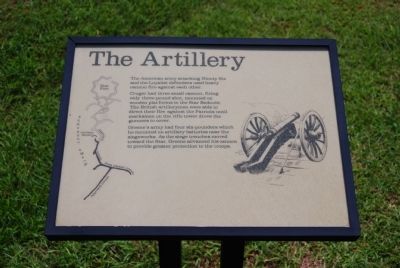
Photographed By Brian Scott, September 5, 2008
3. Original The Artillery Marker
The American army attacked Ninety Six and the Loyalist defenders used heavy cannon fire against each other.
Cruger had three small cannon, firing only three pound shot, mounted on wooden platforms in the Star Redoubt. The British artillerymen were able to direct their fire against the Patriots until marksmen on the rifle tower drove the gunners to cover.
Greene's army had four six pounders which he mounted on artillery batteries near the siegeworks. As the siege trenches moved toward the Star, Greene advanced his cannon to provide greater protection to the troops.
Cruger had three small cannon, firing only three pound shot, mounted on wooden platforms in the Star Redoubt. The British artillerymen were able to direct their fire against the Patriots until marksmen on the rifle tower drove the gunners to cover.
Greene's army had four six pounders which he mounted on artillery batteries near the siegeworks. As the siege trenches moved toward the Star, Greene advanced his cannon to provide greater protection to the troops.
Credits. This page was last revised on November 2, 2018. It was originally submitted on September 7, 2008, by Brian Scott of Anderson, South Carolina. This page has been viewed 829 times since then and 20 times this year. Last updated on October 30, 2018, by Bruce Guthrie of Silver Spring, Maryland. Photos: 1, 2. submitted on July 11, 2010, by Brian Scott of Anderson, South Carolina. 3. submitted on September 7, 2008, by Brian Scott of Anderson, South Carolina. 4. submitted on July 11, 2010, by Brian Scott of Anderson, South Carolina. 5, 6. submitted on September 7, 2008, by Brian Scott of Anderson, South Carolina. 7. submitted on July 11, 2010, by Brian Scott of Anderson, South Carolina. • Andrew Ruppenstein was the editor who published this page.
